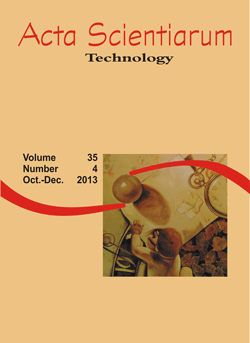<b>Structural features and inactivation of coagulation proteases of a sulfated polysaccharidic fraction from <i>Caulerpa cupressoides</i> var. <i>lycopodium</i> (Caulerpaceae, Chlorophyta)</b> - doi: 10.4025/actascitechnol.v35i4.16709
DOI:
https://doi.org/10.4025/actascitechnol.v35i4.16709Palavras-chave:
Caulerpaceae, polysulfated, chemical analysis, coagulation, modulator actionResumo
Studies on biopolymers from macroalgae suggested sulfated polysaccharides (SPs) as research agents to investigate events related to haemostasis. Caulerpa cupressoides var. lycopodium is a marine green alga containing three SPs fractions (SP1, SP2 and SP3). SP2 had anticoagulant (in vitro) and anti- and prothrombotic (in vivo) actions; however, its effect on the coagulation system is not fully understood. This study aimed to determine the infrared (IR) spectroscopy, chemical composition (CC), elemental microanalysis (EM), molecular weight (MW) and the effect on coagulation proteases of SP2. The presence of sulfate ester, galactose-6-sulfate, uronic acid and glycoside linkages for IR spectrum; contents of sulfate (28%), total sugars (40%) and uronic acids (7.18%) for CC; and content of carbon (21.98%), sulfate (4.27%), nitrogen (1.3%) and hydrogen (4.86%) for EM were obtained. The average molecular weights of four different SPs (SP-1, SP-2, SP-3 and SP-4) subfractions from the SP2 ranged from ~ 8 to >100 kDa. SP2 was tested on coagulation proteases (thrombin and factor Xa) in the presence of antithrombin (AT) and heparin cofactor II (HCII) using human plasma, being both thrombin and factor Xa target proteases inhibited, but requiring a concentration of about 2.5-fold higher of HCII than the thrombin inactivation by AT.
Â
Â
Downloads
Downloads
Publicado
Como Citar
Edição
Seção
Licença
DECLARAÇíO DE ORIGINALIDADE E DIREITOS AUTORAIS
Declaro que o presente artigo é original, não tendo sido submetido í publicação em qualquer outro periódico nacional ou internacional, quer seja em parte ou em sua totalidade.
Os direitos autorais pertencem exclusivamente aos autores. Os direitos de licenciamento utilizados pelo periódico é a licença Creative Commons Attribution 4.0 (CC BY 4.0): são permitidos o compartilhamento (cópia e distribuição do material em qualqer meio ou formato) e adaptação (remix, transformação e criação de material a partir do conteúdo assim licenciado para quaisquer fins, inclusive comerciais.
Recomenda-se a leitura desse link para maiores informações sobre o tema: fornecimento de créditos e referências de forma correta, entre outros detalhes cruciais para uso adequado do material licenciado.















